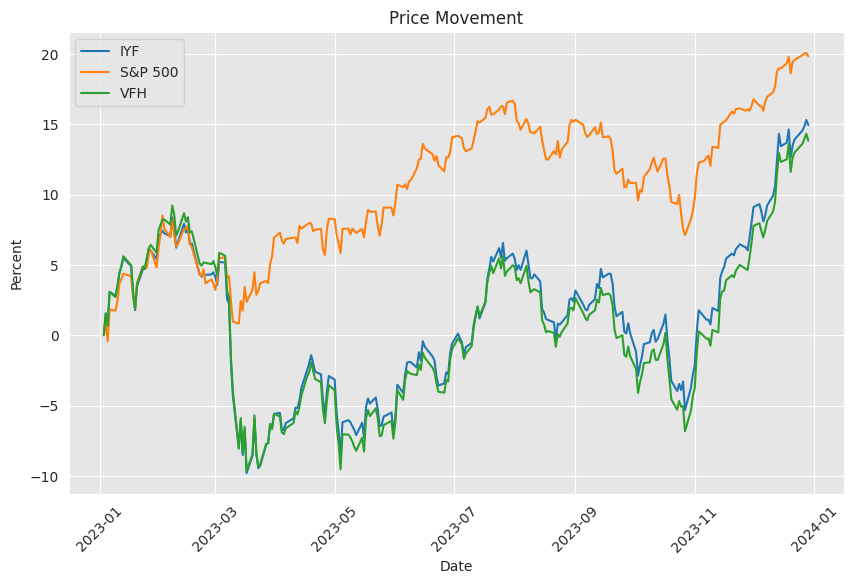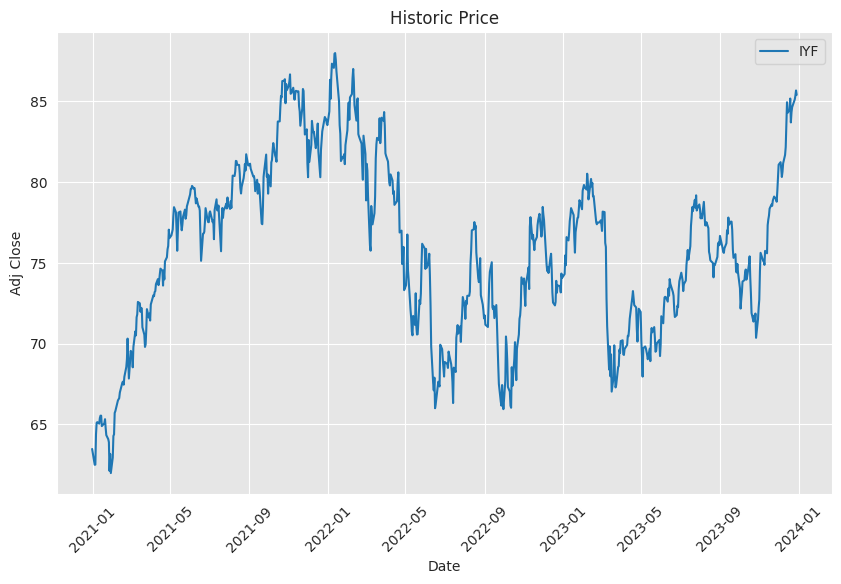iShares U.S. Financials ETF (ticker: IYF)
2023-12-30
 The iShares U.S. Financials ETF, with the ticker symbol IYF, provides investors with an opportunity to gain broad exposure to the U.S. financial sector, which includes a diverse range of industries such as banks, insurance companies, credit services, and investment funds. As an exchange-traded fund, IYF tracks the performance of the Dow Jones U.S. Financials Index, seeking to replicate its investment results before fees and expenses. This ETF is a suitable option for investors looking for a sector-specific investment vehicle that offers liquidity, diversification within the financial sector, and the potential for capital appreciation. IYF is managed by BlackRock and benefits from the firm's extensive experience and resources in the ETF marketplace. It is important for potential investors to consider the fund's expense ratio, historical performance, dividend yield, and assets under management when evaluating it as part of their investment portfolio. As with all sector funds, the performance of the IYF is closely tied to the economic and regulatory conditions affecting the financial industry.
The iShares U.S. Financials ETF, with the ticker symbol IYF, provides investors with an opportunity to gain broad exposure to the U.S. financial sector, which includes a diverse range of industries such as banks, insurance companies, credit services, and investment funds. As an exchange-traded fund, IYF tracks the performance of the Dow Jones U.S. Financials Index, seeking to replicate its investment results before fees and expenses. This ETF is a suitable option for investors looking for a sector-specific investment vehicle that offers liquidity, diversification within the financial sector, and the potential for capital appreciation. IYF is managed by BlackRock and benefits from the firm's extensive experience and resources in the ETF marketplace. It is important for potential investors to consider the fund's expense ratio, historical performance, dividend yield, and assets under management when evaluating it as part of their investment portfolio. As with all sector funds, the performance of the IYF is closely tied to the economic and regulatory conditions affecting the financial industry.
| Previous Close | 85.68 | Open | 85.66 | Day Low | 85.13 |
| Day High | 85.725 | PE Ratio (TTM) | 15.04 | Volume | 112,790 |
| Average Volume | 152,395 | Average Volume (10 days) | 100,480 | Bid | 83.49 |
| Ask | 89.00 | Bid Size | 800 | Ask Size | 900 |
| Yield | 1.77% | Total Assets | 1,904,810,496 | 52 Week Low | 66.91 |
| 52 Week High | 85.84 | 50 Day Average | 78.9196 | 200 Day Average | 75.37205 |
| Trailing Dividend Rate | 1.082 | Trailing Dividend Yield | 1.26% | NAV Price | 85.69033 |
| YTD Return | 15.70% | Beta (3 Year) | 1.07 | Three Year Average Return | 10.98% |
| Five Year Average Return | 12.18% | Fund Inception Date | 958953600 |
 The technical analysis of iShares U.S. Financials ETF (IYF) suggests that the price action over the last few trading days has been characterized by a positive trend. This observation is reinforced by the closing prices consistently nearing or surpassing previous highs. The adjustment of the Parabolic SAR (stop and reverse) indicator, shifting beneath the price candles, indicates a bullish trend confirmation. In conjunction with the escalating On Balance Volume (OBV), which is currently at 0.08692 million, the buying pressure appears to be sustaining momentum.
The technical analysis of iShares U.S. Financials ETF (IYF) suggests that the price action over the last few trading days has been characterized by a positive trend. This observation is reinforced by the closing prices consistently nearing or surpassing previous highs. The adjustment of the Parabolic SAR (stop and reverse) indicator, shifting beneath the price candles, indicates a bullish trend confirmation. In conjunction with the escalating On Balance Volume (OBV), which is currently at 0.08692 million, the buying pressure appears to be sustaining momentum.
The Moving Average Convergence Divergence (MACD) histogram, however, has taken a negative turn as per the last recorded value of -0.064886. This hints at a potential decrease in the momentum or a corrective phase in the near term. Despite this, the Extended Market Official Price (EMOP), or the regular market close, has shown resilience by staying close to the 52-week high of 85.84.
Looking ahead, various factors bode well for a continued positive price trajectory over the next few months. The trailing price-to-earnings (PE) ratio standing at a steady 15.039339 suggests relative value retention in the current market conditions. Furthermore, a dividend yield of approximately 1.77% provides an additional layer of investment appeal, supporting the overall sentiment.
The stability of the average daily volume is sound, with recent trading volumes not exhibiting extreme volatility. The fifty-day average price is significantly lower than the current level, illustrating a steady upward trend over the past two months. The gap between the fifty-day and two-hundred-day moving averages is expanding, which is a classic bull market signal.
The year-to-date (YTD) return of 0.157004 showcases solid performance, potentially fostering investor confidence. The beta, which measures market-related volatility, remains around 1.07, indicating that the fund's price movements are slightly more volatile than the market as a whole. This could entail higher gains during market upswings for risk-tolerant investors.
In conclusion, technical indicators and the fund's characteristics point towards a likelihood of sustained positive momentum over the forthcoming months, with room for potential short-term corrective movements based on the MACD histogram. The fund appeals both as a growth instrument and a source of dividends, underpinning healthy investor sentiment. It should be noted, however, that market conditions are subject to change and various external economic factors can also influence the price trajectory.
Investors should continue to monitor market and economic indicators for potential shifts in sentiment or fundamentals that could impact this assessment. Regular analysis updates would be essential to capture any emerging trends or reversals in the financial sector, which IYF represents.
The iShares U.S. Financials ETF (IYF) is a barometer of the U.S. financial sector, encapsulating the dynamic forces at play within this segment of the economy. As events unfold globally, the ETF reflects the intricate interplay between localized incidents and their broader financial reverberations. This phenomenon, often termed the "butterfly effect" in chaos theory, is aptly demonstrated in the financial sector's response to major events.
One such event drawing significant attention within the financial sector is the recent turmoil involving Silicon Valley Bank (SVB). The collapse of this institution reverberated through the market, challenging the sectors perception of risk, particularly in the realm of smaller, regional banks. The failure of SVB, while initially perceived as an isolated incident, escalated into panic about the risk management strategies of similar institutions, showing just how interconnected the financial system is.
Following the SVB issue, investors and stakeholders have been reminded about the vital role that confidence and assurance play within the banking and investment sectors. The importance of deposit guarantees becomes ever more prominent in maintaining the stability of these institutions. This is a global sentiment, shared by market participants who rely on these foundational mechanisms to shield against losses.
The interconnectedness is further evident as international capital markets scrutinize the likelihood of the U.S. Federal Reserve and other central banks adjusting their monetary policies. Initially focused on combating inflation through rate hikes, there is now speculation whether central banks may reassess their strategy in light of recent banking challenges, further proving how events in one region can affect global strategies and policies.
The situation has also brought regulatory environments into the spotlight. Prior to the downfall of SVB, there had been significant advocacy for deregulation in the U.S. and U.K. Nonetheless, the current climate seems to be shifting towards more stringent regulatory oversight and supervision, potentially at the expense of growth and increased operational costs for businesses and banks.
SVB's predominately startup-focused clientele has highlighted the need for diversity in banking relationships and emphasizes the importance of rigorous due diligence. Furthermore, secure assets like U.S. Treasury Bills are scrutinized for their ability to keep up with the rates, raising concerns about liquidity that previously seemed unfounded.
During these tumultuous times, the lesson on concentration risk becomes poignant. This lesson is not limited to supply chain strategies but extends to the essentials of commercial banking. The emphasis on diversification is a cornerstone that businesses and investors are learning to navigate to mitigate potential risks.
Turning to the scenario with Credit Suisse (CS), the market observed the fragility of investor confidence. Despite CS's efforts to restructure, legacy issues surrounding risk management have led to a cautious approach among investors, reinforcing the constant need for financial prudence.
Despite the challenges, there are always opportunities for the astute investor. These market players continue to seek advantage in volatile conditions, evidencing the globalized and opportunistic nature of the finance industry.
Warren Buffett's Berkshire Hathaway Inc., featured as a top holding in the iShares U.S. Financials ETF, is a prime example of strategic investing maneuvers that gather wide market attention. Recently, Berkshire Hathaway's portfolio saw a sell-off of about $7 billion in equities, indicating a meaningful shift in the conglomerate's strategy. This sell-off activity involved adjustments across various sectors, and it's notable that Berkshire also reduced positions in several major companies, showcasing the companys agility in responding to market conditions.
Some of Berkshire's sales were diminutive, indicating a possible inclination to maintain a presence in specific sectors while reducing exposure. Also intriguing was the undisclosed stock Berkshire continues to accumulate, a move that has generated considerable market speculation.
However, amidst these sell-offs, Berkshire Hathaway's venture into Sirius XM with a purchase of 9.7 million shares signals the conglomerate's continued active participation in the market. Reviewing Berkshire's quarterly earnings reports hints that the company remains bullish on the banking, insurance, and finance sectors, dovetailing with increased investments in these areas.
| company | symbol | percent |
|---|---|---|
| Berkshire Hathaway Inc Class B | BRK-B | 12.76 |
| JPMorgan Chase & Co | JPM | 9.05 |
| Bank of America Corp | BAC | 4.56 |
| Wells Fargo & Co | WFC | 3.86 |
| S&P Global Inc | SPGI | 3.15 |
| BlackRock Inc | BLK | 2.63 |
| The Goldman Sachs Group Inc | GS | 2.60 |
| Marsh & McLennan Companies Inc | MMC | 2.33 |
| Progressive Corp | PGR | 2.26 |
| Morgan Stanley | MS | 2.25 |
For individuals seeking a cogent investment strategy akin to Buffett's but within a diversified ETF, the iShares U.S. Financials ETF offers exposure to a broad range of financial institutions. The ETF not only includes significant positions in companies such as Berkshire Hathaway, it also encompasses other financial entities that encompass banks, insurance companies, and credit card issuers. This allows for an investment profile that can potentially mirror the value play that Berkshire Hathaway signifies with its P/E ratio of 13.5x.
Investors and analysts continually monitor the financial sector as it adapts to the evolving market conditions. Berkshire's recent moves, indicative of Buffett's discerning eye for value and opportunistic plays, serve as valuable signals of broader market trends. The iShares U.S. Financials ETF, mirroring some of Berkshire's moves and staying buoyant amid market turbulence, illustrates the sector's resilience and potential for those looking for diversified exposure to the financial sector.
Similar Companies in Exchange-Traded Funds:
Vanguard Financials ETF (VFH), Report: SPDR Financial Select Sector Fund (XLF), SPDR Financial Select Sector Fund (XLF), Fidelity MSCI Financials Index ETF (FNCL), Report: Invesco KBW Bank ETF (KBWB), Invesco KBW Bank ETF (KBWB), First Trust Financials AlphaDEX Fund (FXO)
News Links:
https://www.fool.com/investing/2023/11/20/buffett-berkshire-hathaway-mystery-stock/
Copyright © 2023 Tiny Computers (email@tinycomputers.io)
Report ID: W50wrX
https://reports.tinycomputers.io/IYF/IYF-2023-12-30.html Home